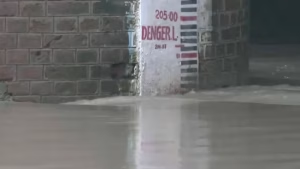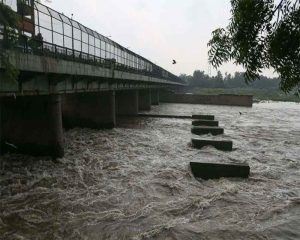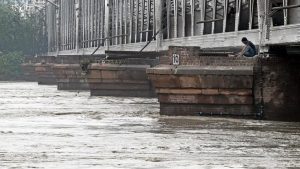New Delhi – The Yamuna Water Level Delhi has reached a concerning 204.61 metres at the Old Railway Bridge on Wednesday morning, maintaining its position above the critical warning mark of 204.50 metres for the second consecutive day. This alarming rise in the Yamuna Water Level Delhi has prompted authorities to issue comprehensive flood warnings and implement precautionary measures across the national capital.
Officials monitoring the Yamuna Water Level Delhi have confirmed that the river continues to pose significant flood risks to the city. The sustained elevation above warning levels indicates a persistent threat that requires immediate attention from flood control authorities and residents living in vulnerable areas along the river’s embankments.
Central Water Commission Issues Danger Mark Alert

The Central Water Commission issued a critical flood warning on Tuesday evening, predicting that the Yamuna Water Level Delhi will likely cross the danger mark of 205.3 metres by Wednesday evening. This escalation in the Yamuna Water Level Delhi represents a serious threat to low-lying areas and communities residing near the river’s path through the capital.
The commission’s alert specifically advised officers to maintain constant vigilance in their respective jurisdictions and take necessary preventive actions. These measures include warning people residing near river embankments about the rising Yamuna Water Level Delhi and making immediate arrangements to relocate them to safer locations if required.
According to the established flood management protocol, the Yamuna Water Level Delhi warning mark stands at 204.5 metres, while the danger mark is set at 205.3 metres. Evacuation procedures are automatically triggered when the Yamuna Water Level Delhi reaches 206 metres, indicating the severity of the current situation as water levels approach these critical thresholds.
Old Railway Bridge Serves as Key Monitoring Point


The Old Railway Bridge functions as the primary observation point for tracking the Yamuna Water Level Delhi and assessing potential flood risks throughout the city. This strategic location provides authorities with real-time data essential for flood management and early warning systems. The consistent monitoring at this point revealed that the Yamuna Water Level Delhi stood at 204.61 metres at 9 AM on Wednesday.
This monitoring station plays a crucial role in Delhi’s flood preparedness infrastructure, enabling authorities to track changes in the Yamuna Water Level Delhi and implement appropriate response measures. The bridge’s location offers optimal conditions for accurate water level measurements and serves as a reliable indicator of flood conditions affecting the broader Delhi region.
Barrage Releases Drive Water Level Increase

Officials from the central flood control room have identified the primary cause behind the rising Yamuna Water Level Delhi as the substantial volumes of water being released from upstream barrages. The continuous discharge from Wazirabad and Hathnikund barrages is directly contributing to the elevated Yamuna Water Level Delhi, with forecasts indicating further increases in the coming hours.
Also Read: Devastating Vaishnodevi Landslide Claims 32 Lives in Jammu
An official explained that the reason for the increase in the Yamuna Water Level Delhi is predominantly due to high-volume water releases from these critical infrastructure points. “It is forecast that the water level may increase further,” the official stated, emphasizing the ongoing nature of this flood threat.
Current data from the flood control department reveals that approximately 37,230 cusecs of water is being released from Wazirabad every hour, while the Hathnikund Barrage is discharging around 52,448 cusecs hourly. These substantial releases are directly impacting the Yamuna Water Level Delhi and contributing to the sustained elevation above warning levels.
Water Transit Time and Downstream Impact


The water released from upstream barrages typically requires 48 to 50 hours to reach Delhi, creating a delayed but predictable impact on the Yamuna Water Level Delhi. This transit time provides authorities with a crucial window for preparation and response, though even lower discharge volumes from upstream locations are contributing to the rising Yamuna Water Level Delhi.
Understanding this timeline is essential for effective flood management, as it allows officials to anticipate changes in the Yamuna Water Level Delhi based on upstream activities. The current situation demonstrates how sustained releases from multiple barrages can create cumulative effects on the Yamuna Water Level Delhi, even when individual discharge rates might seem manageable.
Ongoing Monitoring and Safety Measures
Authorities continue to monitor the Yamuna Water Level around the clock, with particular attention to the approaching danger mark threshold. The sustained elevation above warning levels for two consecutive days indicates a serious flood risk that requires comprehensive response measures and community preparedness.
As the Yamuna Water Level approaches the critical danger mark, residents in flood-prone areas must remain alert and prepared for potential evacuation orders. The situation demands continued vigilance from both authorities and citizens to ensure public safety and minimize flood-related risks throughout the capital.

